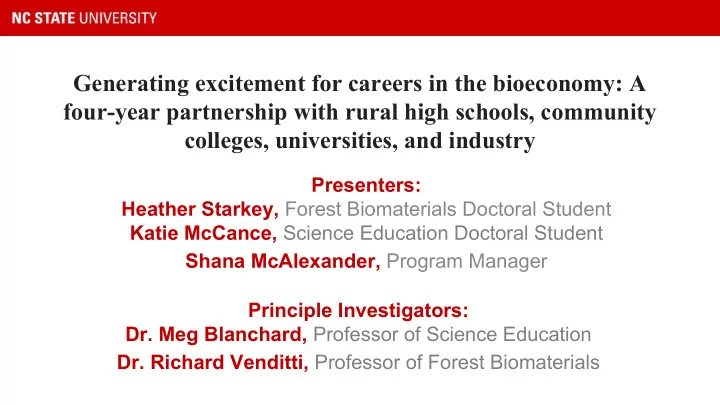

Generating excitement for careers in the bioeconomy: A four-year partnership with rural high schools, community colleges, universities, and industry Presenters: Heather Starkey, Forest Biomaterials Doctoral Student Katie McCance, Science Education Doctoral Student Shana McAlexander, Program Manager Principle Investigators: Dr. Meg Blanchard, Professor of Science Education Dr. Richard Venditti, Professor of Forest Biomaterials
What is the Circular Bioeconomy?
Careers in the Bioeconomy (DOE, 2017)
The Sustainable Bioproducts & Bioenergy Program Participants High School NC State Faculty & Undergraduate Science Teachers Industry Partners Graduate Students Students & Students
The Sustainable Bioproducts & Bioenergy Program Goals 1. Create a professional development program for rural high school teachers 2. Promote awareness and interest in Bioeconomy Careers with bioproducts and bioenergy lesson activities for high school STEM disciplines. 3. Develop five online college courses and undergraduate certificate program critical for the bioproducts and bioenergy industries 4. Develop an internship and career opportunity network by initiating connections for undergraduate students to industry, government, and research organizations
Program Overview for HS Teachers Fall 2018 Summer 2019 Summer 2020 • • Orientation 4-day PD • 3-day PD • • Course 1 Classroom kit 2018 2019 2020 2021 Fall 2019-Spring 2020 Fall 2020-Spring 2021 Spring 2019 • • Implement activities Implement activities • Course 2 • • Career Event Career Event
Introducing Lessons Develop lessons that: • Highlight Sustainable Development and Design • Spark awareness and Interest for Bioeconomy Careers • Are designed based on Next Generation Science Standards • Integrate STEM
The 5E Learning Model (BCBS, 2006) https://ctl.yale.edu/BackwardDesign
Designing Bioproducts & Bioenergy for Sustainability 1. Making Biofuels: Engineering Optimal Conditions 2. Circular Bioeconomy: Bioproduct Comic Strip 3. Life Cycle Assessment: Which is more sustainable?
Break Out Session 3 groups x 12 minutes
SBBP Pictures https://video214.com/play/sLogUAyw2oA580Ho2CYdzg/s/dark
Reflection on Activities What did you get out of the activities? Do you have suggestions for improvement? Could you envision implementing similar activities in your teaching/learning environment? Other comments and questions?
Acknowledgements This project is supported by the USDA-NIFA project, award number: 2017-67009-26771 Dr. Meg Blanchard Franklin Zambrano Gotera Professor of Science Education Joe Sagues Dr. Richard Venditti Kristen Tomberlin Professor of Forest Biomaterials Forest Biomaterials Doctoral Students
Partners
References Department of Energy. (2017). Jobs and Economic Impact of a Billion-Ton Bioeconomy . Retrieved from https://www.energy.gov/sites/prod/files/2017/06/f35/jobs_and_economic_impact_of_a_billion_ton_bioe conomy.pdf Office of Energy Efficiency and Renewable Energy. (n.d.). Bioenergy Career Map. Retrieved from https://www.energy.gov/eere/bioenergy/bioenergy-career-map (2018). Teaching and Learning Frameworks . Retrieved from https://ctl.yale.edu/BackwardDesign. Bybee, R. W., Taylor, J. A., Gardner, A., Van Scotter, P., Powell, J. C., Westbrook, A., & Landes, N. (2006). The BSCS 5E instructional model: Origins and effectiveness. Colorado Springs, Co: BSCS , 5 , 88-98.
Thank you! Heather Starkey hrstarke@ncsu.edu Katie McCance Shana McAlexander krmccanc@ncsu.edu slmcalex@ncsu.edu go.ncsu.edu/sbbp
Making Biofuels: Engineering Optimal Conditions
Making Biofuels: Engineering Optimal Conditions
Life Cycle Assessment “Which is more Sustainable?” ● Using mathematical models to quantify environmental, social, and economic impacts. ● Often used to compare impacts of a small set of products or processes. ● We need to use models that are consistent across industries. Comparing Apples to Apples. (Kendall 2012)
Designing and evaluating a “green” shoe 1. Check out your own shoes a. What are they made of? Write a list of components. b. What inputs and outputs would you expect for your shoe? 2. Review literature on sustainable shoe design 3. Examine given data for leather, synthetic, bioproduct shoe. 4. Develop a simple model for comparing the 3 shoes. 5. Discuss and compare models. http://go.ncsu.edu/lcamodelingbtg
Increasing Complexity Framework for Energy Use Indicators in LCA EPLCA http://eplca.jrc.ec.europa.eu/?page_id=1159 Integr Environ Assess Manag 12, 2016
Recommend
More recommend